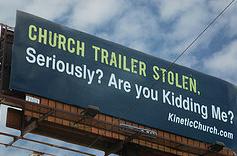Several high profile church theft cases are originating from both outside and inside the church. This past week, KGW reported that for the past five weeks, a woman has been going to special events at several Gresham area churches and stealing both cash and credit cards from attendees’ purses. So far, four different churches have been targeted.
Earlier this year, several teenagers were caught on surveillance tape burglarizing and vandalizing a West Linn church. Back in June, a man vandalized a Seattle church—completely in the nude. He also broke the windows and a mirror of a pickup parked nearby, leaving blood inside the church as well. Since he was reportedly infected with Hepatitis C, the church had to be treated as a biohazard area causing the church further hardship because it had to relocate its Sunday services for about a month until the church could be treated, according to The Seattle Times.
But it’s not just outsiders that steal.
The Patriot-News in Harrisburg, Pennsylvania reports that Barry R. Herr, the treasurer of the Pennsylvania Lower Susquehanna Synod of the Evangelical Lutheran Church in America, recently was sentenced to 30 months in federal prison for stealing more than $1 million to support his classic car hobby.
Also in Pennsylvania, a former secretary for the Good Shepherd School in Camp Hill was sentenced last year to probation and community service for embezzling $85,000. And in July, local police reported that the secretary of Mount Holly Springs United Methodist Church embezzled more that $35,000 over a seven-year period.
According to Oregon Live, a Great Falls, Montana woman was given a three-year deferred sentence and required to pay back the $17,000 she stole from the Lutheran Church Montana Synod, which covers about 150 congregations in Montana and northern Wyoming.
And in Washington, Patti A. Whitbeck recently pled guilty to second-degree theft of the Immanuel Baptist Church in Hoquiam Washington, according to The Seattle Times.
Some of the larger, more affluent churches are eventually able to absorb the financial challenges caused by the theft, but many of the smaller, less affluent churches are often devastated by the loss and unable to fully recover.
The Patriot-News reports that in 2003, Scott Lee Chambers was sentenced to 15 to 30 months in state prison after embezzling more than $117,000 from St. James Episcopal Church in Pennsylvania, which has an annual operating budget of just $60,000. The church was nearly destroyed as a result.
Experts speculate that the bad economy might prompt some people to steal who may never have considered it before and churches that in the past would not have reported the theft are doing so now in order to seek restitution in order to survive.
Often, treasurers, secretaries and even clergy begin stealing small amounts of money with the intention of paying it back at a later time only to realize afterward that they are unable to replace it as anticipated. And once they realize the early theft goes undetected, they are more likely to get in deeper and deeper until there is no way out.
Church members, clergy and staff who have been victimized by the theft often experience intense sadness and a loss of trust. And church leaders sometimes face blame and accusation by the congregation resulting in a drop in donations and further financial challenges.
“You run into this ethical dilemma: We’re the church and we’re supposed to forgive,” says Barbara Myers, a spokesperson for the Pennsylvania Lutheran church where Herr worked, “That doesn’t let you off for your legal responsibility. It’s a crime.”
According to experts, churches, synagogues, temples and mosques are susceptible to such theft because most don’t have adequate checks and balances in place when it comes to safeguarding their money and other assets.
“Churches have always assumed they were one big happy family and they didn’t have to think about those things,” states Anson Shupe, the author of five books on church misconduct, “They were wrong.”
Disclaimer: Articles featured on Oregon Report are the creation, responsibility and opinion of the authoring individual or organization which is featured at the top of every article.



